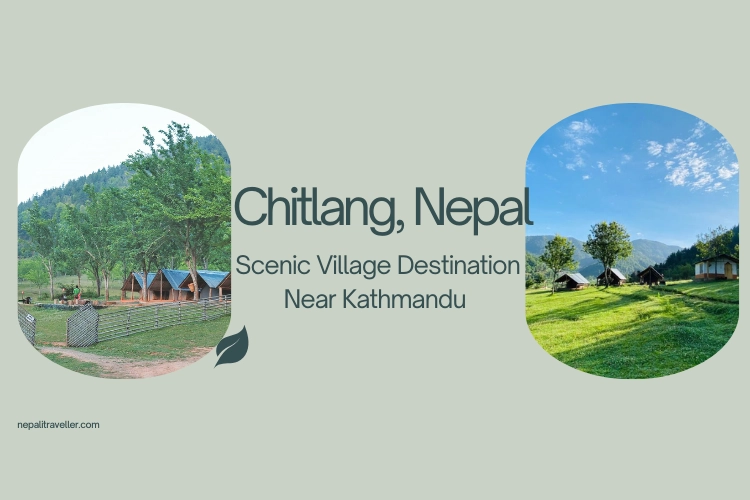Settled in the verdant green hills of Nepal, Chitlang is a peaceful village that encompasses a skirt of history, culture, and natural beauty. As an ancient Newar village with centuries-old traditions and stories, Chitlang offers visitors a true experience of Nepali culture, away from the hustling city life. Chitlang’s history springs from the Lichchavi period, and the village still hosts vibrant harvest festivals and the rich landscape is reminiscent of a fairy tale. Chitlang is an undiscovered gem waiting to be explored.
Table of Contents
ToggleAncient History | Historical Significance
Chitlang’s history is incredibly ancient, and archeological evidence shows that it was inhabited as early as 300 BC. Chitlang rested along an old trade route that passed between India and Tibet, which was an important passage used by traders and travelers from both countries as well as pilgrims traveling to her places of worship. Discovery of inscriptions within Chitlang from the Lichchavi era, including at locations like Ganeshthan (where there is-Lakheswar Mahadev Temple), verifies the village’s most ancient roots. The inscriptions also detail the early rulers of the region, like King Udaydev of the Licchavi dynasty, and King Amshubarma, voicing a connection between Chitlang and the great initial events of Nepali political and cultural developments.
Chitlang’s history is interesting in that it has a history with Gopalis, who are traditionally herders, and some historians believe they are descendants of the Gopali rulers during their agro-pastoral time, which is long ago in Nepal’s history. It is likely that some of the various settlements around Chitlang, like Toukhel and Nhulgaun, were established by King Amshubarma for those sheep herders. There are also remnants of Malla royalty’s history in Chitlang, including shrines and caves that Malla royalty took refuge in when they fled to Chitlang after Prithvi Narayan Shah conquered.
There is evidence of Ashoka’s influence through the Ashoka Chaitya in Chitlang—a stone stupa purportedly erected by Ashoka more than two thousand years ago, representing an early Buddhist monument in the area. Interestingly, the name “Chitlang” most likely came from the Newari “Chaittya Lhown,” indicating these stone chaityas or stupas.
A Cultural Mosaic: Communities and Traditions
Chitlang comprises a mixture of communities that are, in the main, Newar, Tamang, Khas, all of which add to the variety of cultural practices in Chitlang. Newar culture is prominently found in the other parts of the greater Chitlang area (wards 3, 4, 5, and 6) and Tamang culture also can be found in Chitlang (i.e., previously, ward one) but the other areas reflect interesting combinations of ethnic groups, each living their own culture, but in apparent harmony with other cultures.
Festivals are an essential part of life in Chitlang because of old political and trade connections to Kathmandu and Lalitpur (Patan). Chitlang is home to many Jatras and religious festivals. A clear example is the Red Machhendra Nath Jatra because it is celebrated mainly in Lalitpur but also received puja offerings from Chitlang. This indicates potential cultural and religious links with Chitlang and the rest of Nepal, especially Tamang and Khas. In fact, there is a small temple of Karunamaya or Machhindra Nath close to Tahaphale.
Similar to the Red Machhendra Nath Jatra, these examples show some local “Yemba Thanegu” events. There are many local events similar to the Indra Jatra festival in Kathmandu. This is an example of the combination of cultures and adaptation, which must have happened over long periods of time, showing how cultures and festivals meld over time. Letting people see how the traditional music, dances, and rituals that survive, help carry the ideas of musical and cultural expression to successive generations, while allowing visitors an experience of Nepal’s living heritage in a rural village.
Architectural and Artistic Heritage
As you walk through Chitlang, you will be amazed at the authentic traditional architecture which remains very much intact. The village features intricately carved wooden homes, stone water spouts, and brick-built homes grouped around common courtyards called patis. The hardwood and stone carving are evidence of the skilled craftsmanship of the Newar community who, it is believed, have lived here for centuries.
The village is spread with numerous temples and shrines that signify the religious and historic significance of the area. In addition to the Ashoka Chaitya, the other significant temples include a Swet Bhairab and other names dedicated to local deities, which act as a spiritual and cultural focal point not only for the community but any visitors to the area. There are several inscriptions carved on stones and rock taps that can be found in and around Chitlang, which are historically significant, as they tell the history of this area of Nepal.
Natural Beauty and Ecological Wealth
Chitlang is located high in the northern point of the Makwanpur district near the towering Chandragiri hills which rise to an elevation of approximately 8,289 feet. Visitors visiting the village can enjoy striking breathtaking views of the hills and valleys below, and it certainly could be considered an eco-tourist paradise. Plus, the air is clean, with terraced farming, forest, and colorful blooming rhododendrons in spring.
Chitlang is often characterized as an organic village where traditional forms of local agriculture are still cultivated and biodiversity is maintained. This blissful setting lends itself to being an ideal place for travelers trying to escape the chaos of city life, offering hiking, bird watching, and a cultural experience in a tranquil environment.
Modern Day Chitlang: Tourism and Transformation
Over the past few years, Chitlang has evolved from a sleepy agricultural village to a developing eco-tourism destination. Improved road infrastructure and accessibility have opened the village more to tourists wanting to experience the historical sites and amenities, allowing them to experience a homestay with a local family, enjoy traditional Newari cuisine, and participate in workshops on local craft and farming practices.
The eco-tourism initiatives focus on sustainable initiatives to bring some economies into the communities while maintaining the ecological balance in the village. The increased visibility of the cultural heritage aspect now provides opportunities for larger audiences to experience and appreciate Chitlang for what it has to offer without losing its authentic way of life.
Moreover, the significance of the historical events in Nepal associated with Chitlang also provides an educational focus from the travel aspect. As noted earlier, Chitlang was a refuge for political dissidents organized by activists to provide sanctuary from political persecution (during the time when Nepal was trying to gain independence from the Rana Polity), thus becoming a place of resistance and resilience.
Conclusion
Chitlang is more than just an idyllic village; it is a living museum of Nepal’s ancient past, a colorful representation of many cultures, and a beautiful natural environment. The carved stone water spouts, colorful festivals and the breathtaking Himalayan views all combine to immerse visitors in a timeless experience that spans centuries.
For travelers seeking to experience the essence of Nepal beyond a country of mountains and temples, Chitlang offers an experience that is truly steeped in its history and culture, where history, culture and nature are connected in an incredible way. In a country where tourism is growing, it will be necessary to make sustainable efforts to maintain the distinct heritage and tranquility of Chitlang that makes it a rewarding place to visit in Nepal.
Frequently Asked Questions (FAQs)
1. What is Chitlang famous for?
Chitlang is famous for its ancient Newar history, exquisite architecture, rich history dating back to the Lichchavi period, and the beautiful natural landscape. Visitors are attracted to the stone inscriptions, the Ashoka stupas, the terraced hillsides, and the deep appreciation for culture through festivals that bring together Newar, Tamang and Khas traditions.
2. Is Chitlang a good place for eco-tourism and homestays?
Chitlang is an emerging eco-tourism destination with real homestays, organic farming, and many opportunities for eco-friendly and sustainable tourism. Visitors can enjoy authentic Newari dishes, walk across the countryside, and engage in cultural experiences in a relaxed rural context just outside of Kathmandu.
3. How old is Chitlang village?
Chitlang is believed to be over 300 years old, and there are archaeological finds and inscriptions dating back to the Lichchavi and Malla periods. It is an important part of the Nepalese historical and political development, and once served as a prominent stop along the trade route between India and Tibet.







